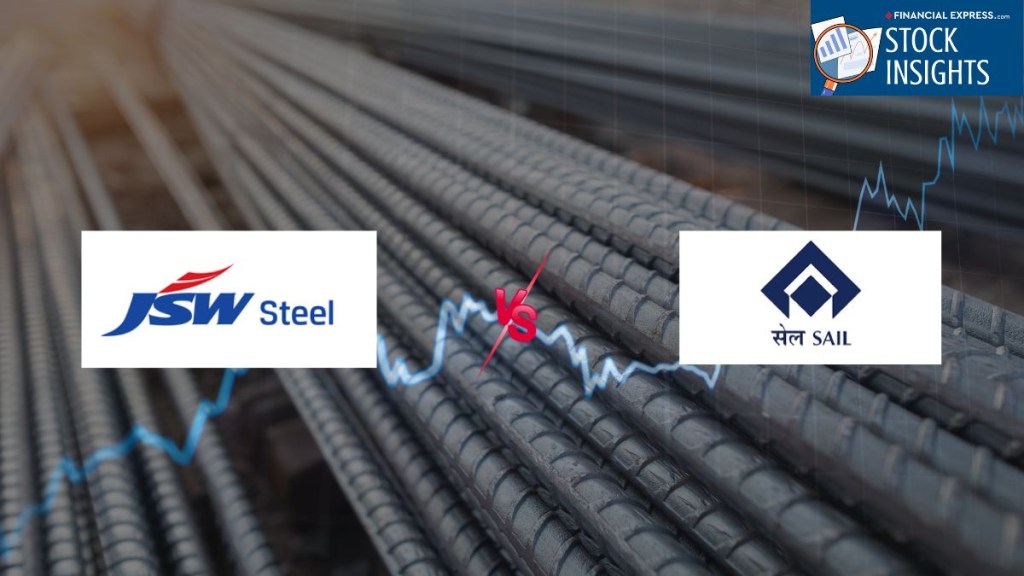The steel industry has seen renewed investor interest on Dalal Street with the central government earlier imposing a 12% safeguard duty to protect the local industry from cheaper imports from east Asian countries. And recent media reports highlight that India’s steel imports were 4.9 million tonnes in the first half of FY26 compared to 5.78 million tonnes a year earlier.
Steel stocks like SAIL and JSW Steel are trading close to their respective 52-week highs. And while price realisations were under pressure in the second quarter of FY26, cost management was key for large steel players.
Realisations squeeze SAIL, JSW manages costs
SAIL’s standalone revenue from operations grew 8.2% y-o-y to Rs 26,703.9 crore in the September 2025 quarter. The New Delhi-based company sold 4.9 million tonnes of steel products in the September 2025 quarter vis-a-vis 4.1 million tonnes a year earlier.However, realisations fell nearly 9% y-o-y to Rs 54,496 per tonne in the second quarter of FY26.
Steel companies typically have a combination of long-term and short-term contracts with customers, and the volatility in global steel prices and steel imports into the country has put pressure on SAIL’s realisations in the second quarter of FY26.
SAIL also had higher input costs — changes in inventories of finished goods, work-in-progress and by-product were Rs 1,347.3 crore in the September 2025 quarter vis-a-vis negative Rs 678.9 crore a year earlier. Its core operating profit margin fell 230 basis points y-o-y to 9.5% in the September 2025 quarter. And SAIL’s standalone net profit fell nearly 49% y-o-y to Rs crore in the September 2025 quarter.
Earlier, JSW Steel’s consolidated revenue from operations grew 13.8% y-o-y to Rs 45,152 crore in the September 2025. JSW Steel’s consolidated sales were 7.34 million tonnes in the September 2025 quarter vis-a-vis 6.13 million tonnes a year earlier, a rise of 19.7% y-o-y and this was attributed to the company’s Dolvi plant operating at optimum capacity post planned maintenance shutdown in the June 2025 quarter and enhanced output from subsidiaries, JSW Vijayanagar Metallics and Bhushan Power and Steel.
Its realisations were Rs 61,515 per tonne in the September 2025 quarter, a fall of nearly 5% on a y-o-y basis. Nevertheless, JSW Steel’s consolidated operating profit margin rose 210 basis points to 15.8 % in the September 2025 quarter, and that was thanks to a tight check on costs. Its mining premium and royalties were 3.2% of consolidated revenue from operations in the September 2025 quarter vis-a-vis 4.5% a year earlier.
Higher steel sales and cost checks helped JSW Steel’s consolidated net profit jump nearly 307% y-o-y to Rs 1,646 crore in the second quarter of FY26.
Efficient use of assets
Screener has highlighted JSW Steel return on capital employed (ROCE) was 8.1% during FY26 while it was 6.76 % for SAIL.
Capex Plans: JSW’s Aggression vs. SAIL’s Pace
JSW Steel’s consolidated capital expenditure was Rs 6,535 crores during the first half of FY26, and it expects to spend nearly Rs 20,000 crores during FY26. As part of its expansion plans, in August, 2025, JSW Steel announced plans to expand its cold rolled grain oriented (CRGO) electrical steel capacity, with the Nashik facility to increase capacity from 50,000 tonnes to 250,000 tonnes per annum
JSW Steel’s consolidated steel capacity of 35.7 million tonnes will rise to 43.4 million tonnes over the next three years.
Meanwhile, SAIL has envisaged phase-1 expansion of its integrated steel plants at Burnpur, Durgapur, Bokaro, Rourkela and Bhilai for enhancing its steel capacity from nearly 19 million tonnes at the end of FY25 to nearly 35 million tonnes by 2030-31. Its capital expenditure planned for FY26 is Rs 7,500 crore.
Valuations and investors on Dalal Street
Investors will be closely monitoring the trends in global steel prices and steel imports into the country closely, and its impact on local steel companies. And while no GST rate cut was announced for the steel sector, a pick-up in activity from user industries like auto and construction sectors in the second half of FY26, will help the steel sector going forward.
SAIL declared its results after the close of Wednesday trading and in intra-day Friday trade, the stock was broadly flat at Rs 135.7. The SAIL stock had hit a 52-week high of Rs 143.2 on 29 October, 2025.
JSW Steel was broadly flat at Rs 1,210 during intra-day Friday trade and not too far from its 52-week high of Rs 1,223.7 that was reached on 29 October, 2025.
SAIL trades at a P/E of more than 20 times while JSW Steel trades at more than 48 times according to Screener.in.
Clearly, steel stocks have factored in the growth opportunities over the next few quarters.
Amriteshwar Mathur is a financial journalist with over 20 years of experience.
The writer and his family have no shareholding in any of the stocks mentioned in the article.
Disclaimer: The website managers, its employee(s), and contributors/writers/authors of articles have or may have an outstanding buy or sell position or holding in the securities, options on securities or other related investments of issuers and/or companies discussed therein. The content of the articles and the interpretation of data are solely the personal views of the contributors/ writers/authors. Investors must make their own investment decisions based on their specific objectives, resources and only after consulting such independent advisors as may be necessary.

